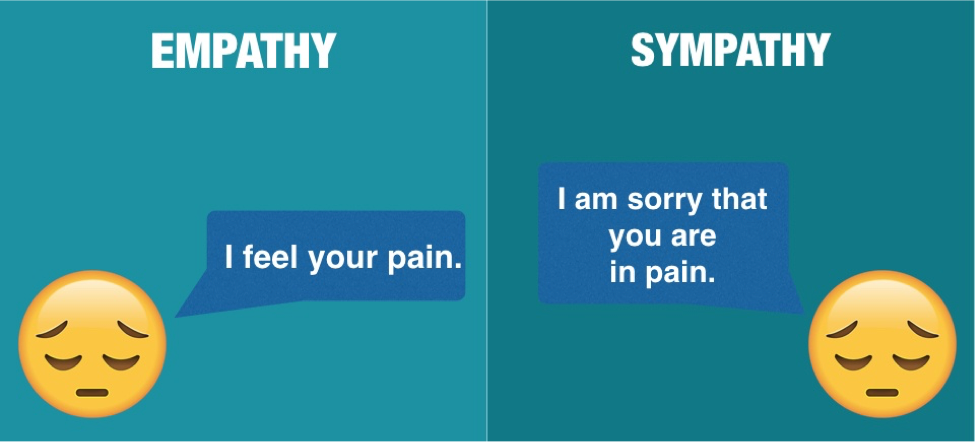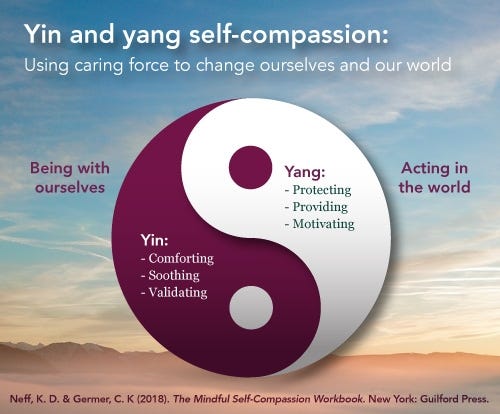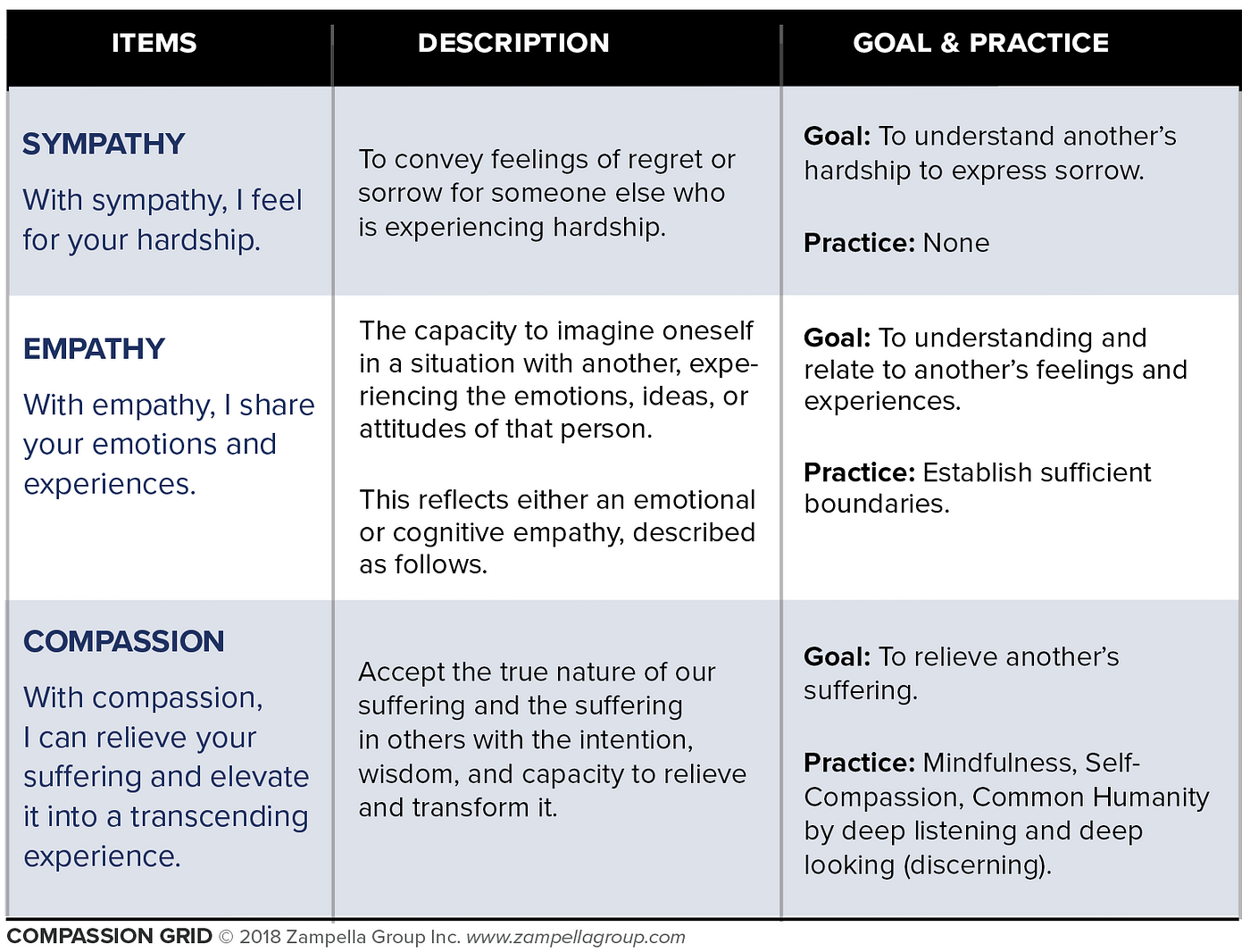Is There a Difference Between Compassion and Sympathy
Distinguishing Compassion from Sympathy and Empathy
![]()

Being of service often requires a deep connection to human experiences. Ever notice how we live with the words that describe such experiences? Of late, I've observed words such as sympathy, empathy, or compassion employed to describe political leaders in certain situations. Usually, terms are bandied about by commentators or casual observers, so I let them pass.
But as professionals in the human experienc e , I find it critical for coaches, counselors, educators, and even consultants to more critically observe what each situation requires. Do we see a need to show sorrow, to relate to another's experience, or to reduce suffering?
To explore this territory, I will begin with sympathy, then explore empathy, and finally distinguish compassion from both. Both sympathy and empathy have roots in the Greek word pathos, which means "suffering, feeling."
Pity and Sympathy
To develop sympathy, first, let's explore pity, which can often be confused for sympathy.
Pity is a feeling of sadness or commiseration for someone who is either worse off than you or is worse off than some normative standard, which is why you can pity yourself.
Very few people want to be pitied, yet at times we do just that — or we pity ourselves. When you listen to someone's suffering and respond with "poor you," you have just pitied them.
Sympathy entered the English language in the mid-1500s and became used to convey feelings of regret or sorrow for someone else who is experiencing hardship. We often see this in messages of support and sorrow for others in a time of need (e.g., "my sympathies"). You feel bad for them and express sorrow, but you can't personally relate.

The World of Empathy
Introduced in the late 1800s, the word empathy has come to refer to the capacity to imagine oneself in a situation with another, experiencing the emotions, ideas, or opinions of that person. This reflects either an emotional or cognitive empathy, described as follows.
Emotional empathy consists of three separate components. To quote Sara D. Hodges and Michael D. Myers from the Encyclopedia of Social Psychology:
- "The first [component] is feeling the same emotion as another person . . .
- The second component, personal distress, refers to feelings of distress in response to perceiving another's plight . . .
- The third emotional component, feeling with another person , is the one most frequently associated with the study of empathy in psychology."
Cognitive empathy is also known as "empathic accuracy." Hodges and Myers discuss it as "having more complete and accurate knowledge about the contents of another person's mind, including how the person feels."
Cognitive empathy is more like a skill that is developed to better understand another's perspective, such as their attitudes, worldview, or ideas. We have found a strong correlation between listening skills and the ability to access this form of empathy.
Unlike sympathy, empathy isn't just used for unpleasant feelings. You can empathize with someone's happiness, too.
This leads us to compassion.
Compassion
When researching this blog, I found compassion often used to describe pity, sympathy, and even both types of empathy. This reveals our confusion about compassion, which can be traced to an unclear definition.
Fundamentally, compassion is composed of com (together with) and passion (to suffer).
Tapping into 2,600 years of Buddhist wisdom, we can deepen our understanding of the practice of compassion — "to suffer with" — from a more common psychological view that tends to sound much like empathy and sympathy.
Zen master Thich Nhat Hanh views compassion as "the intention and capacity to relieve and transform suffering and lighten sorrows." According to Hanh, "we [must] practice mindfulness, deep listening, and deep looking" to develop compassion.
Thus, we associate compassion with an active desire to alleviate the suffering of its object, in the self or in others.
With sympathy, I feel for your hardship; with empathy, I share your emotions. With compassion, I can share your suffering and elevate it into a universal "common humanity" and transcending experience.
The relationship to suffering begins with understanding the truth — or true nature — of one's own suffering or the suffering of another. This requires three elements: self-compassion, common humanity, and mindfulness.
1 — Self-compassion

If we are unable to be with our own suffering, we cannot be with another's. This requires an awareness that discerns between being judgmental and being kind. Self-compassion invites us to be gracious, warm, and caring toward ourselves when we fail, suffer, or become disappointed.
The practice begins with becoming aware of our own suffering, expectations, and imperfections without judging them as negative thoughts about ourselves.
Author and researcher Kristen Neff, Ph.D. Neff suggests that "Instead of mercilessly judging and criticizing yourself for various inadequacies or shortcomings, self-compassion means you are kind and understanding when confronted with personal failings."
Neff has also distinguished Self-Compassion from Self-pity, Self-indulgent and Self-esteem, and she offers a special piece on Why Women Need Fierce Self-Compassion.
2 — Common Humanity
Kristen Neff beautifully describes this notion of common humanity, distinguishing it from self-pity.
"While self-pity says 'poor me,' self-compassion recognizes suffering is part of the shared human experience. The pain I feel in difficult times is the same pain that you feel in difficult times. The triggers are different, the circumstances are different, the degree of pain is different, but the basic experience is the same."
3 — Mindfulness
Understanding common humanity and practicing self-compassion requires our willingness to observe our negative thoughts and emotions with openness and clarity with mindful awareness.
Mindfulness is a non-reactive awareness that cultivates a receptive mind to observe thoughts and feelings as they are, without trying to suppress or deny them. This openness also loosens the grip that thoughts have on us and our ability to reify those thoughts. See our blog on Mental Hygiene.

Idiot Compassion.
Often, the compassionate thing to do may not seem empathetic and may lack sympathy. Additionally, honesty without compassion can be cruelty. The issue is whether we are willing to view the source of suffering or not. If we bypass this examination, we lean toward "idiot compassion," a term I first encountered through the writings of Tibetan Buddhist and author, Pema Chodron.
Idiot compassion refers to enabling — i.e., the general tendency to give people what they want because you can't bear to see them suffering.
Chodron exposes the danger in this:
"instead of offering a friend medicine, bitter though it may be when ingested, you feed them more poison — at the very least, you don't take it away from them. This, she says, is not compassion at all. It's selfishness, as you're more concerned with your own feelings than attending to your friend's actual needs."
This phenomenon is due to our inability to experience our own suffering, which also induces us to avoid the suffering of others. We commit a compassion bypass by acting nice, enabling deeds, or simply overlooking items that require our attention. In this sense, we actually increase suffering rather than relieving it.
Philosopher Ken Wilber states this well:
"Real compassion includes wisdom and so it makes judgments of care and concern; it says some things are good, and some things are bad, and I will choose to act only on those things that are informed by wisdom and care."
Compassion Fatigue.
Compassion fatigue is defined as "the indifference to charitable appeals on behalf of those who are suffering, experienced as a result of the frequency or number of such appeals" (accumulative effect of absorbing trauma or suffering).
Much of this definition relies on a faulty understanding of compassion as an outward phenomenon.
"Compassion fatigue" speaks to a dimension of burnout; I see this more akin to "empathy fatigue." Without the wisdom required in compassion, empathy and open-hearted care often find us relating to others' emotions without sufficient boundaries. We become overwhelmed, merge the self with others, or become swept up in the needs of others.
Recall the three elements of compassion from above: self-compassion, common humanity, and mindfulness. In this regard, we are also adding something else — practice. Compassion is more than a definition or description of a concept. These three interdependent parts must act as a system of practices to ensure that compassion has a built-in self-regulation. If we are practicing compassion, not idiot compassion, then we are first practicing self-compassion.
The term compassion fatigue eliminates the wisdom necessary for compassion. It reduces compassion to an emotion or experience — rather than a state of being cultivated with practice — and dismisses the fundamental aspect of self-compassion, which is necessary to understand and be with our own suffering.

In Sum: Compassion is a Practice
As professionals, we offer interventions to support others. Consider each situation you encounter and the care you might render. Then, observe the need and discern the understanding of those involved.
Thupten Jinpa, Ph.D., is the Dalai Lama's principal English translator and author of the course Compassion Cultivation Training (CCT). Jinpa posits that compassion is a four-step process, which I've paraphrased slightly:
- Awareness of the true nature of suffering.
- Sensitive concern related to being emotionally moved by suffering.
- A wish to see that suffering relieved.
- Wise responsiveness or readiness to help relieve that suffering.
Compassion is a practice that involves Eastern wisdom and includes Western notions of feelings, thoughts, and emotions. We transcend suffering with practice to realize our common humanity. With practice, we learn to tend to our own suffering to relieve the suffering of others.
Additional blog posts on this topic: Mental Hygiene: The Overlooked Capacity, and Mindfulness Minus Wisdom: Moving to Materialism; and, the workbook, The Mindful Self-Compassion Workbook by Kristin Neff and Chris Germer
Educator, coach, activist, and researcher at Bhavana Learning Group (previously, Zampella Group), I work with coaches, learning professionals and executives, dwelling at the intersection of Eastern wisdom and human potential. I am interested in learning, as a human endeavor distinct from "knowing" or "training."
Connect with our blog, Learning Curve , and learning community to receive our weekly digest . Join us on Twitter and our LinkedIn , and Facebook page.
Is There a Difference Between Compassion and Sympathy
Source: https://tonyvzampella.medium.com/distinguishing-compassion-from-sympathy-and-empathy-6036fca2f7cb